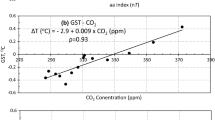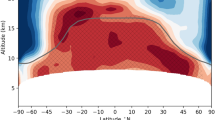Abstract
We investigate whether the global temperature anomaly is associated with the solar North-South asymmetry using data archived approximately for five solar cycles. We are motivated by both the accumulating evidence for the connection of Galactic cosmic-rays (GCRs) to the cloud coverage and recent finding of the association of GCR influx and the solar North-South asymmetry. We have analyzed the data of the observed sunspot, the GCR influx observed at the Moscow station, and the global temperature anomaly. We have found that the mean global temperature anomaly is systematically smaller (∼0.56 in the unit of its standard deviation) during the period when the solar northern hemisphere is more active than the solar southern hemisphere. The difference in the mean value of the global temperature anomaly for the two data sets sub-sampled according to the solar North-South asymmetry is large and statistically significant. We suggest the solar North-South asymmetry is related to the global temperature anomaly through modulating the amount of GCR influx. Finally, we conclude by discussing its implications on a climate model and a direction of future work.
Similar content being viewed by others
References
Benestad, R. E., and G. A. Schmidt, 2008: Solar trends and global warming, J. Geophys. Res., 114, D14101.
Brohan, P., J. J. Kennedy, I. Harris, S. F. B. Tett, and P. D. Jones, 2006: Uncertainty estimates in regional and global observed temperature changes: A new data set from 1850, J. Geophys. Res., 111(D12), D12106.
Carslaw, K. S., R. G. Harrison, and J. Kirkby, 2002: Cosmic Rays, Clouds, and Climate, Science, 298(5599), 1732–1737.
Chang, H.-Y., 2009: Periodicity of North South asymmetry of sunspot area revisited: Cepstrum analysis, New Astron., 14(2), 133–138.
Cho, I.-H., Y.-S. Kwak, K.-S. Cho, H.-S. Choi, and H.-Y. Chang, 2009: On the Relation Between the Sun and Climate Change with the Solar North-South Asymmetry, J. Astron. Space Sci., 26(1), 25–30.
—, —, H.-Y. Chang, K.-S. Cho, Park Y.-D. and H.-S. Choi, 2011: Dependence of GCRs influx on the Solar North-South Asymmetry, J. Atmos. Sol.-Terr. Phys., 73, 1723–1726.
Egorova, L. V., V. Y. Vovk, and O. A. Troshichev, 2000: Influence of variations of the cosmic rays on atmospheric pressure and temperature in the Southern geomagnetic pole region, J. Atmos. Sol.-Terr. Phys., 62(11), 955–966.
Emmert, J. T., and J. M. Picone, 2010: Climatology of globally averaged thermospheric mass density, J. Geophys. Res., 115(A9), A09326.
Fligge, M., S. K. Solanki, and Y. C. Unruh, 2000: Modeling irradiance variations from the surface distribution of the solar magnetic field, Astron. Astrophys., 353, 380–388.
Forbush, S. E., 1954: World-Wide Cosmic-Ray Variations, 1937–1952, J. Geophys. Res., 59(4), 525–542.
Friis-Christensen, E., and K. Lassen, 1991: Length of the Solar Cycle: An Indicator of Solar Activity Closely Associated with Climate, Science, 254(5032), 698–700.
Fröhlich, C., 2006: Solar irradiance variability since 1978: Revision of the PMOD composite during solar cycle 21, Space Sci. Rev., 125, 53–65.
Georgieva, K., 2002: Long-term changes in atmospheric circulation, earth rotation rate and north-south solar asymmetry, Phys. Chem. Earth, 27(6–8), 433–440.
—, B. Kirov, and C. Bianchi, 2005: Long-term variations in the correlation between solar activity and climate, Memorie della Societá Astronomica Italiana, 76, 965.
—, —, P. Tonev, V. Guineva, and D. Atanasov, 2007: Long-term variations in the correlation between NAO and solar activity: The importance of north south solar activity asymmetry for atmospheric circulation, Adv. Space Res., 40(7), 1152–1166.
Goode, P. R., and Coauthors, 2003: Sunshine, Earthshine and Climate Change: II. Solar Origins of Variations in the Earth’s Albedo, J. Korean. Astron. Soc., 36(S1), S83–S91.
Haigh, J. D., 2007: The Sun and the Earth’s Climate, Liv. Rev. Sol. Phys., 4(2).
Hansen, J., and Coauthors, 2002: Climate forcings in Goddard Institute for Space Studies SI2000 simulations, J. Geophys. Res., 107(D18), ACL 2–1.
Hathaway, D. H., and R. M. Wilson, 2004: What the Sunspot Record Tells Us About Space Climate, Sol. Phys., 224(1–2), 5–19.
Intergovernmental Panel on Climate Change, 2007: Climate Change 2008: The Physical Science Basis. Cambridge University Press. [Total page range].
Javaraiah, J., and R. K. Ulrich, 2006: Solar-Cycle-Related Variations in the Solar Differential Rotation and Meridional Flow: A Comparison, Sol. Phys., 237(2), 245–265.
Jokipii, J. R., 1989: The physics of cosmic-ray modulation, Adv. Space Res., 9(12), 105–119.
Krivova, N. A., S. K. Solanki, M. Fligge, and Y. C. Unruh, 2003: Reconstruction of solar irradiance variations in cycle 23: Is solar surface magnetism the cause?, Astron. Astrophys., 399, L1–L4.
Marsh, N. D., and H. Svensmark, 2000: Low Cloud Properties Influenced by Cosmic Rays, Phys. Rev. Lett., 85(23), 5004–5007.
Nagashima, K., and L. Morishita, 1980: Twenty-two year modulation of cosmic rays associated with polarity reversal of polar magnetic field of the sun, Planet. Space Sci., 28, 195–205.
Ney, E. P., 1959: Cosmic Radiation and the Weather, Nature, 183(4659), 451–452.
Pudovkin, M. I., 2004: Influence of solar activity on the lower atmosphere state, Int. J. Geomagn. Aeron., 5(2), GI2007.
—, S. V. Veretenenko, R. Pellinen, and E. Kyrö, 1997: Meteorological characteristic changes in the high-latitudinal atmosphere associated with forbush decreases of the galactic cosmic rays, Adv. Space Res., 20(6), 1169–1172.
Roldugin, V. C., and B. A. Tinsley, 2004: Atmospheric transparency changes associated with solar wind-induced atmospheric electricity variations, J. Atmos. Sol.-Terr. Phys., 66(13–14), 1143–1149.
Sabbah, I., and M. L. Duldig, 2007: Solar Polarity Dependence of Cosmic Ray Power Spectra Observed with Mawson Underground Muon Telescopes, Sol. Phys., 243(2), 231–235.
Scafetta, N., 2010: Empirical analysis of the solar contribution to global mean air surface temperature change, J. Atmos. Sol.-Terr. Phys., 71, 17–18, 1916–1923.
Solanki, S. K., N. A. Krivova, and T. Wenzler, 2005: Irradiance models. Adv. Space Res., 35(3), 376–383.
Stott, P. A., J. F. B. Mitchell, M. R. Allen, T. L. Delworth, J. M. Gregory, G. A. Meehl, and B. D. Santer, 2006: Observational constraints on past attributable warming and predictions of future global warming, J. Climate., 19, 3055–3069.
Svensmark, H., 2007: Cosmoclimatology: a new theory emerges, Astron. Geophys., 48(1), 1.18–1.24.
—, and E. Friis-Christensen, 1997: Variation of cosmic ray flux and global cloud coverage-a missing link in solar-climate relationships, J. Atmos. Sol.-Terr. Phys., 59, 1225–1232.
Troshichev, O., 2008: Solar wind influence on atmospheric processes in winter Antarctica, J. Atmos. Sol.-Terr. Phys., 70(18), 2381–2396.
Usoskin, I. G., 2008: A History of Solar Activity over Millennia, Solar Physics, 5(3).
Wenzler, T., S. K. Solanki, N. A. Krivova, and C. Fröhlich, 2006: Reconstruction of solar irradiance variations in cycles 21–23 based on surface magnetic fields, Astron. Astrophys., 460, 583–595.
Zaatri, A., R. Komm, H. González, R. Howe, and T. Corbard, 2006: North South Asymmetry of Zonal and Meridional Flows Determined From Ring Diagram Analysis of Gong ++ Data, Sol. Phys., 236(2), 227–244.
Author information
Authors and Affiliations
Corresponding author
Rights and permissions
About this article
Cite this article
Cho, IH., Kwak, YS., Chang, HY. et al. The global temperature anomaly and solar North-South asymmetry. Asia-Pacific J Atmos Sci 48, 253–257 (2012). https://doi.org/10.1007/s13143-012-0025-3
Received:
Revised:
Accepted:
Published:
Issue Date:
DOI: https://doi.org/10.1007/s13143-012-0025-3




